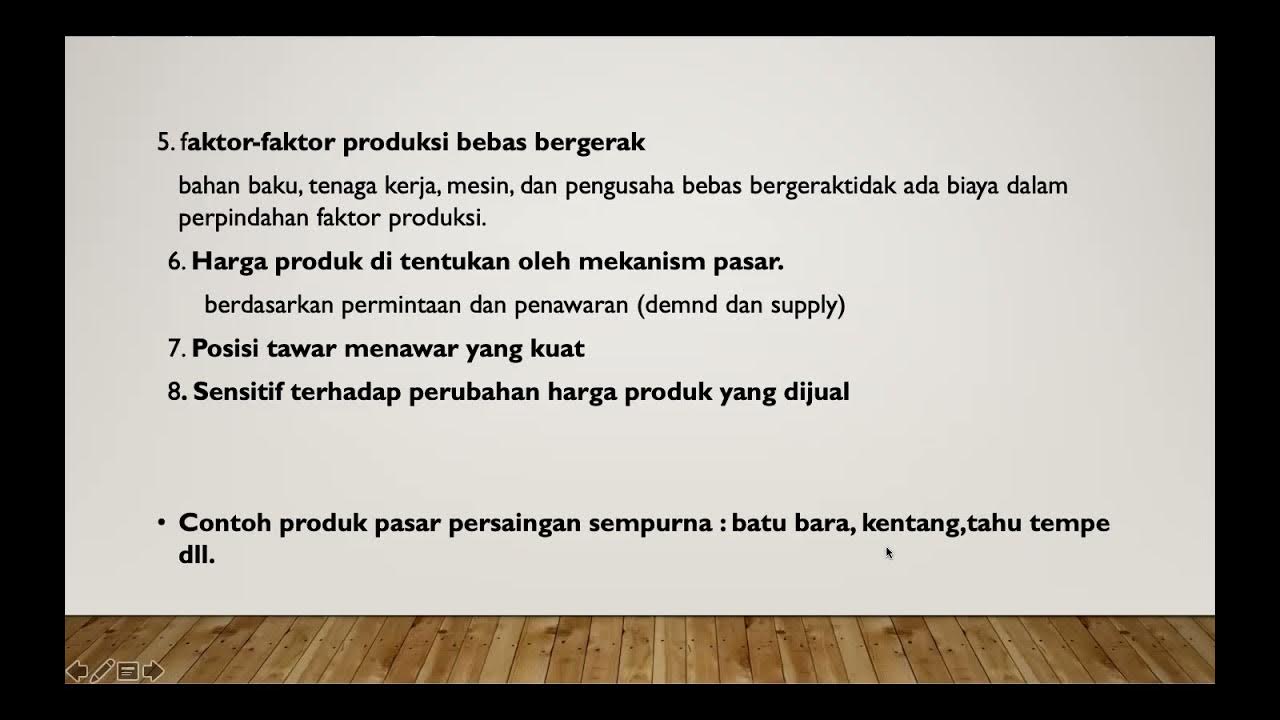Differences between Monopoly and Oligopoly.
Summary
TLDRThis video explains the differences between Monopoly and Oligopoly in market competition. It defines Monopoly as a market where only one seller offers a unique product with no close substitutes, while Oligopoly involves a small number of sellers offering either similar or differentiated products. The video highlights key differences such as the number of players, product differentiation, pricing strategies, and control over the market. Monopoly results in high prices and minimal competition, whereas Oligopoly sees fair prices and some level of competition. Barriers to entry are also discussed, with legal or economic factors restricting Monopoly and economies of scale being the main challenge in Oligopoly.
Takeaways
- 😀 Monopoly is a market structure where only one seller offers a unique product with no close substitutes.
- 😀 Oligopoly is a market structure with a small number of firms (2 to 10) offering either homogeneous or differentiated products.
- 😀 In a monopoly, the market is dominated by a single player, while an oligopoly has a limited number of competing firms.
- 😀 Monopoly products are highly differentiated because there are no close alternatives, whereas oligopoly products can be slightly differentiated or similar.
- 😀 Competition is nonexistent in a monopoly, but oligopoly markets have limited competition between firms.
- 😀 High prices are common in a monopoly due to the lack of competition, while prices in an oligopoly are generally more competitive.
- 😀 In a monopoly, the single seller has significant control over pricing, but in an oligopoly, control is shared among firms with less power over price changes.
- 😀 Price setting in a monopoly is determined by consumer demand, while oligopoly pricing is influenced by competitors' prices.
- 😀 Monopoly markets often have high barriers to entry, including legal, economic, or institutional factors.
- 😀 The main barrier to entry in an oligopoly is economies of scale, which makes it difficult for new firms to compete effectively.
Q & A
What is a Monopoly in the context of market competition?
-A Monopoly is a market condition where only one seller offers a unique product with no close substitutes, effectively dominating the entire market.
How does an Oligopoly differ from a Monopoly?
-An Oligopoly is a market structure where there are a few firms (usually between 2 to 10) selling either homogeneous or differentiated products, whereas a Monopoly has only one seller in the market.
What is the level of product differentiation in a Monopoly?
-Product differentiation in a Monopoly is extreme because the seller offers a unique product with no close substitutes.
How many players typically exist in an Oligopoly market?
-An Oligopoly typically consists of 2 to 10 firms competing in the market.
How does competition in a Monopoly compare to an Oligopoly?
-In a Monopoly, there is no competition since there is only one seller, while in an Oligopoly, there is slight competition among the few firms in the market.
What is the price level in a Monopoly versus an Oligopoly?
-In a Monopoly, high prices are typically charged due to the lack of competition, while in an Oligopoly, firms tend to charge fair prices due to the presence of competing companies.
How much control do firms have over pricing in a Monopoly and an Oligopoly?
-In a Monopoly, the firm has considerable control over pricing, while in an Oligopoly, control over price is limited because firms are influenced by the pricing decisions of competitors.
What factors determine pricing in a Monopoly and an Oligopoly?
-In a Monopoly, pricing is determined by the demand of consumers for the product. In an Oligopoly, pricing is influenced by the prices set by competitors in the market.
What are some barriers to entry in a Monopoly market?
-Barriers to entry in a Monopoly market can be legal, economic, or institutional, preventing other firms from entering the market.
What is the primary barrier to entry in an Oligopoly market?
-The major barrier to entry in an Oligopoly is economies of scale, where existing firms benefit from cost advantages that new entrants can't easily match.
Outlines

Esta sección está disponible solo para usuarios con suscripción. Por favor, mejora tu plan para acceder a esta parte.
Mejorar ahoraMindmap

Esta sección está disponible solo para usuarios con suscripción. Por favor, mejora tu plan para acceder a esta parte.
Mejorar ahoraKeywords

Esta sección está disponible solo para usuarios con suscripción. Por favor, mejora tu plan para acceder a esta parte.
Mejorar ahoraHighlights

Esta sección está disponible solo para usuarios con suscripción. Por favor, mejora tu plan para acceder a esta parte.
Mejorar ahoraTranscripts

Esta sección está disponible solo para usuarios con suscripción. Por favor, mejora tu plan para acceder a esta parte.
Mejorar ahoraVer Más Videos Relacionados

Monopoly vs Oligopoly | Understanding Market Structures

STRUKTUR PASAR

Ekonomi Mikro - Struktur Pasar Lainnya

Economics. S5: Market Structures

Estruturas de Mercado: Concorrência Perfeita, Monopólio e Oligopólio

Pasar Persaingan Sempurna, Pasar Monopoli, Pasar Oligopoli, Pasar Persaingan Monopolistik #pasar
5.0 / 5 (0 votes)
